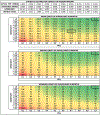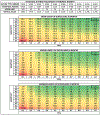Minimizing signal detection time in postmarket sequential analysis: balancing positive predictive value and sensitivity
- PMID: 24700557
- PMCID: PMC7181336
- DOI: 10.1002/pds.3618
Minimizing signal detection time in postmarket sequential analysis: balancing positive predictive value and sensitivity
Abstract
Purpose: Outcome misclassification in retrospective epidemiologic analyses has been well-studied, but little is known about such misclassification with respect to sequential statistical analysis during surveillance of medical product-associated risks, a planned capability of the US Food and Drug Administration's Sentinel System.
Methods: Using a vaccine example, we model and simulate sequential database surveillance in an observational data network using a variety of outcome detection algorithms. We consider how these algorithms, as characterized by sensitivity and positive predictive value, impact the length of surveillance and timeliness of safety signal detection. We show investigators/users of these networks how they can perform preparatory study design calculations that consider outcome misclassification in sequential database surveillance.
Results: Non-differential outcome misclassification generates longer surveillance times and less timely safety signal detection as compared with the case of no misclassification. Inclusive algorithms characterized by high sensitivity but low positive predictive value outperform more narrow algorithms when detecting rare outcomes. This decision calculus may change considerably if medical chart validation procedures were required.
Conclusions: These findings raise important questions regarding the design of observational data networks used for pharmacovigilance. Specifically, there are tradeoffs involved when choosing to populate such networks with component databases that are large as compared with smaller integrated delivery system databases that can more easily access laboratory or clinical data and perform medical chart validation.
Keywords: adverse drug event; bias (epidemiology); outcome measurement error; pharmacoepidemiology; pharmacovigilance; postmarketing product surveillance.
Copyright © 2014 John Wiley & Sons, Ltd.
Conflict of interest statement
CONFLICT OF INTEREST
The authors declare no conflict of interest.
Figures


Similar articles
-
Impact of exposure accrual on sequential postmarket evaluations: a simulation study.Pharmacoepidemiol Drug Saf. 2011 Nov;20(11):1184-91. doi: 10.1002/pds.2223. Epub 2011 Aug 24. Pharmacoepidemiol Drug Saf. 2011. PMID: 22020903
-
Medical product safety surveillance: how many databases to use?Epidemiology. 2013 Sep;24(5):692-9. doi: 10.1097/EDE.0b013e31829dde59. Epidemiology. 2013. PMID: 23867812
-
Challenges in the design and analysis of sequentially monitored postmarket safety surveillance evaluations using electronic observational health care data.Pharmacoepidemiol Drug Saf. 2012 Jan;21 Suppl 1:62-71. doi: 10.1002/pds.2324. Pharmacoepidemiol Drug Saf. 2012. PMID: 22262594
-
Medical device active surveillance of spontaneous reports: A literature review of signal detection methods.Pharmacoepidemiol Drug Saf. 2020 Apr;29(4):369-379. doi: 10.1002/pds.4980. Epub 2020 Mar 3. Pharmacoepidemiol Drug Saf. 2020. PMID: 32128936 Review.
-
An evaluation of statistical approaches to postmarketing surveillance.Stat Med. 2020 Mar 30;39(7):845-874. doi: 10.1002/sim.8447. Epub 2020 Jan 8. Stat Med. 2020. PMID: 31912927 Review.
Cited by
-
A Synthesis of Current Surveillance Planning Methods for the Sequential Monitoring of Drug and Vaccine Adverse Effects Using Electronic Health Care Data.EGEMS (Wash DC). 2016 Sep 6;4(1):1219. doi: 10.13063/2327-9214.1219. eCollection 2016. EGEMS (Wash DC). 2016. PMID: 27713904 Free PMC article.
-
Near real-time vaccine safety surveillance using electronic health records-a systematic review of the application of statistical methods.Pharmacoepidemiol Drug Saf. 2016 Mar;25(3):225-37. doi: 10.1002/pds.3966. Epub 2016 Jan 28. Pharmacoepidemiol Drug Saf. 2016. PMID: 26817940 Free PMC article.
-
Serially Combining Epidemiological Designs Does Not Improve Overall Signal Detection in Vaccine Safety Surveillance.Drug Saf. 2023 Aug;46(8):797-807. doi: 10.1007/s40264-023-01324-1. Epub 2023 Jun 16. Drug Saf. 2023. PMID: 37328600 Free PMC article.
-
An Implementation and Visualization of the Tree-Based Scan Statistic for Safety Event Monitoring in Longitudinal Electronic Health Data.Drug Saf. 2019 Jun;42(6):727-741. doi: 10.1007/s40264-018-00784-0. Drug Saf. 2019. PMID: 30617498
-
Machine learning model combining features from algorithms with different analytical methodologies to detect laboratory-event-related adverse drug reaction signals.PLoS One. 2018 Nov 21;13(11):e0207749. doi: 10.1371/journal.pone.0207749. eCollection 2018. PLoS One. 2018. PMID: 30462745 Free PMC article.
References
Publication types
MeSH terms
Substances
Grants and funding
LinkOut - more resources
Full Text Sources
Other Literature Sources
Medical

